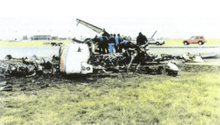United Express Flight 5925
 Overhead view of the Quincy airport. | |
| Accident summary | |
|---|---|
| Date | November 19, 1996 |
| Summary | Runway incursion and Pilot Error on the King Air |
| Site | Quincy Regional Airport, Gilmer Township, Adams County, Illinois, near Quincy, Illinois, United States |
| Total fatalities | 14 (all) |
| Total survivors | 0 |
| First aircraft | |
| Type | Beechcraft 1900C |
| Operator | Great Lakes Airlines for United Express |
| Registration | N87GL[1] |
| Flight origin | Chicago O'Hare International Airport |
| Last stopover | Southeast Iowa Regional Airport |
| Destination | Quincy Regional Airport |
| Passengers | 10 |
| Crew | 2 |
| Survivors | 0 |
| Second aircraft | |
| Type | Beechcraft 65-A90 King Air |
| Operator | private |
| Registration | N1127D[2] |
| Passengers | 0 |
| Crew | 2 |
| Survivors | 0 |
United Express Flight 5925, operated by Great Lakes Airlines with a Beechcraft 1900 twin turboprop, was a regularly scheduled flight from Chicago O'Hare International Airport to Quincy, Illinois, with an intermediate stop in Burlington, Iowa.
On November 19, 1996, the aircraft collided on landing at Quincy with another Beechcraft, a private King Air, that was taking off from an intersecting runway. All occupants of both planes, twelve on board the 1900 and two on board the King Air, were killed as a result.[3]
Synopsis

United Express Flight 5925 had departed from Chicago at 15:25 on November 19, 1996. After a stop at Burlington, Iowa, the flight proceeded to Quincy. Two aircraft at Quincy were ready for departure when Flight 5925 approached. Both a Beechcraft King Air and a Piper Cherokee were proceeding to Runway 04. As Quincy is a non-towered airport, all three aircraft were operating on the same Common Traffic Advisory Frequency. On approach, the United Express crew inquired as to whether the King Air would hold short of the runway, or depart before their arrival. After receiving no response, the United Express crew called again, and received a reply from the Cherokee that they were holding short. However, due to the ground proximity warning system sounding in the 1900s cockpit, only part of the transmission was received by the 1900. Contributing to the cause of the accident was the Cherokee pilot’s interrupted radio transmission, which led to the Beech 1900C pilot’s misunderstanding of the transmission as an indication from the King Air that it would not take off until after Flight 5925 had cleared the runway.
Assuming that both planes were holding, Flight 5925 landed on Runway 13. The King Air, however, had taxied into position on Runway 4, and had begun its takeoff roll when Flight 5925 landed. Both aircraft collided at the intersection of runways 4 and 13. The aircraft skidded for 110 feet (34 m), coming to rest alongside Runway 13, and caught fire. Several pilots in the vicinity of the crash came to the scene, but were unable to open the doors of the aircraft before both planes were destroyed by fire. All 12 aboard the 1900 and both pilots of the King Air perished in the accident.
Cause

The National Transportation Safety Board determined that the cause of the accident was the King Air pilots' failure to effectively monitor both the common frequency and to scan for traffic. A contributing factor was the Cherokee's transmission at the same time as the United Express transmission. Lack of adequate rescue and firefighting equipment was cited as a factor in the high fatality rate.[3]
In popular culture
The crash was featured on Season 15 of Mayday (Air Crash Investigation) on January 6, 2016. The episode aired on the National Geographic Channel (Australia) and Discovery Channel Canada on January 15, 2016 titled "Fatal Transmission".
References
- ↑ "FAA Registry". Federal Aviation Administration.
- ↑ "FAA Registry". Federal Aviation Administration.
- 1 2 "NTSB, Aircraft accident report" (PDF). National Transportation Safety Board. Retrieved May 22, 2015.
External links
- Accident description at the Aviation Safety Network
- NTSB Response to Petition for Reconsideration from Mr. Ed Voorhis